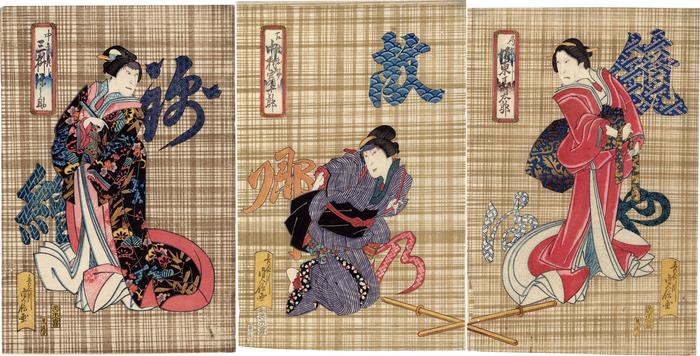Hasegawa Sadanobu I (初代長谷川貞信) (artist 1809 – 1879)
Bandō Jutarō I (坂東寿太郎) as Lady Iwafuji (局岩ふじ) on the right, Nakamura Tomijūrō II (中村富十郎) as the Servant Ohatsu (お初), and Mimasu Gennosuke I (三枡源之助) as Chūrō Onoe (中老尾上) on the left in the play Mirror Mountain: A Woman's Treasury of Loyalty (Kagamiyama Kokyō no Nishikie)
01/1838
30 in x 15 in (Overall dimensions) Japanese color woodblock print
Signed: Hasegawa Sadanobu ga
長谷川貞信画
Publisher: Tenmaya Kihei (Marks 536 - seal 21-193)
Museum of Fine Arts, Boston
Kabuki21 - summary of the play Kagamiyama
Hankyu Culture Foundation - right panel
Hankyu Culture Foundation - left panel
Royal Museums of Art and History, Belgium (via Cultural Japan) - right panel only
Kansai University Library This triptych commemorates a performance of Kagamiyama Kokyō no Nishikie (加賀見山旧錦絵) at Kado Theater in 1838/1.
*****
The curatorial files at the Museum of Fine Arts in Boston say:
The background of the triptych represents a woven plaid fabric, with appliqued letters made of other dyed fabrics spelling out the title of the play. This unusual compositional technique gives a fresh twist to the ever-popular story of the brave maidservant Ohatsu, who foils the plots of the evil lady-in-waiting Iwafuji.The Museum of Fine Arts in Boston gives the title of this play this translation: Color Prints of the Old Home Town at Mirror Mountain.
In Revenge Drama in European Renaissance and Japanese Theatre: From Hamlet to Madame Butterfly by Kevin J. Wetmore, the title is translated as Mirror Mountain: A Woman's Treasury of Loyalty, which Wetmore notes "...is often called 'The Female Chushingura because both the avenger and the target of the revenge are women." (p. 11)
****
This play is referenced in Edo Culture: Daily Life and Diversions in Urban Japan, 1600-1868 by Matsunosuke Nishiyama on page 128:
Rural audiences were often extremely naive. Spectators might climb onto the stage and injure actors playing villains such as Sadakurō in Kanadehon chūshingura or Iwafuji in Kagamiyama kokyō no nishiki-e. Conversely, a handsome actor of young lover roles was lionized by rural girls. Their squeals of delight were sure to accompany him wherever he went.****
Like most kabuki plays known today only a few acts of this play have been preserved and are still being performed. In volume 2 of Kabuki Plays on Stage..., edited by James Brandon and Samuel Leiter, there is a discussion and translation of Kagamiyama Kokyō no Nishikie, pp. 172-212.
****
Illustrated:
1) in black and white in Ukiyo-e Masterpieces in European Collections: Musées Royaux d'Art et d'Histoire, Brussels, vol. 9, Kodansha, 1989, p. 208, #138.
2) only the far left and far right panels in color in Ikeda Bunko, Kamigata yakusha-e shūsei, vol. 2, Osaka, 1998, #12.
Tenmaya Kihei (天満屋喜兵衛) (publisher)
Kyōto-Osaka prints (kamigata-e - 上方絵) (genre)
actor prints (yakusha-e - 役者絵) (genre)
mitate-e (見立て絵) (genre)
Bandō Jūtarō I (初代坂東寿太郎: from 11/1825 to 12/1840) (actor)
Mimasu Gennosuke I (初代三枡源之助) (actor)
Nakamura Tomijūrō II (二代目中村富十郎: 1/1833 to 2/1855) (actor)
Iwafuji, Onoe, Ohatsu (岩藤, 尾上, お初) (role)
Keisei Kagamiyama (けいせい双鏡山) (kabuki)
